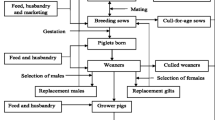Abstract
This study estimated economic values for production traits (dressing percentage (DP), %; live weight for growers (LWg), kg; live weight for sows (LWs), kg) and functional traits (feed intake for growers (FEEDg), feed intake for sow (FEEDs), preweaning survival rate (PrSR), %; postweaning survival (PoSR), %; sow survival rate (SoSR), %, total number of piglets born (TNB) and farrowing interval (FI), days) under different smallholder pig production systems in Kenya. Economic values were estimated considering two production circumstances: fixed-herd and fixed-feed. Under the fixed-herd scenario, economic values were estimated assuming a situation where the herd cannot be increased due to other constraints apart from feed resources. The fixed-feed input scenario assumed that the herd size is restricted by limitation of feed resources available. In addition to the tradition profit model, a risk-rated bio-economic model was used to derive risk-rated economic values. This model accounted for imperfect knowledge concerning risk attitude of farmers and variance of input and output prices. Positive economic values obtained for traits DP, LWg, LWs, PoSR, PrSR, SoSR and TNB indicate that targeting them in improvement would positively impact profitability in pig breeding programmes. Under the fixed-feed basis, the risk-rated economic values for DP, LWg, LWs and SoSR were similar to those obtained under the fixed-herd situation. Accounting for risks in the EVs did not yield errors greater than ±50 % in all the production systems and basis of evaluation meaning there would be relatively little effect on the real genetic gain of a selection index. Therefore, both traditional and risk-rated models can be satisfactorily used to predict profitability in pig breeding programmes.
Similar content being viewed by others
References
Bett, R.C., Kosgey, I.S., Bebe, B.O., Kahi, A.K. (2007). Breeding goals for the Kenya Dual Purpose Goat. II. Estimation of economic values for production and functional traits. Tropical Animal Health and Production, 39:467–475.
Chimonyo, M., Dzama, K., Mapiye, C. (2010). Growth performance and carcass characteristics of indigenous Mukota pigs of Zimbabwe. Tropical Animal Health and Production, 42:1001–1007.
De Vries A.G. (1989): A model to estimate economic values of traits in pig breeding. Livestock Production Science, 21: 49–66.
Dube, B., Mulugeta, S.D., van der Westhuizen, R.R., Dzama, K. (2011). Non-genetic factors affecting growth performance and carcass characteristics of two South African pig breeds. South African Journal of Animal Science, 41(2):161–176.
Harris, D.L., Newman, S. (1994). Breeding for profit: synergism between genetic improvement and livestock production (a review). Journal of Animal Science, 72:2178–2200.
Hermesch, S., Kanis, E., Eissen, J.J. (2003). Economic weights for feed intake in the growing pig derived from a growth model and an economic model. Journal of Animal Science, 81:895–903.
Houška, L., Wolfová, M., Fiedler, J. (2004). Economic weights for production and reproduction traits of pigs in the Czech Republic. Livestock production science, 85:209–221.
Houška, L., Wolfová, M., Nagy, I., Csörnyei, Z., Komlósi, I. (2010). Economic values for traits in Hungary. Czech Journal of Animal Science, 55(4):139–148.
Kahi, A.K., Nitter, G. (2004). Developing breeding schemes for pasture based dairy production systems in Kenya I: Derivation of economic values using profit functions. Livestock Production Science, 88:161–177.
Kosgey, I.S., van Arendonk, J.A.M., Baker, R.L. (2004). Economic values for traits in breeding objectives for sheep in the tropics: impact of tangible and intangible benefits. Livestock Production Science, 143–160.
Kulak, K., Wilton, J.,Fox, G., Dekkers, J. (2003). Comparisons of economic values with and without risk for livestock trait improvement. Livestock Production Science, 79:183–191.
Mbuthia, J.M., Rewe, T.O., Kahi, A.K. (2014) Breeding objectives for pigs in Kenya. I. Bio-economic model development and application to smallholder production systems. Tropical Animal Health and Production, 46:7. doi:10.1007/s11250-014-0719-x
Mutua, F., Arimi,S., Ogara,W., Dewey, C., Schelling,E. (2010). Farmer perceptions on indigenous pig farming in Kakamega district, Western Kenya. Nordic Journal of African Studies, 19(1):43–57.
Nielsen, H.M., Amer, P.R. (2007). An approach to derive economic weights in breeding objectives using partial profile choice experiments. Animal, 1 (9):1254–1262.
Okeno, T.O., Magothe, M.T., Kahi, A.K., Peters, K.J. (2012). Application of risk-rated profit model functions in estimation of economic values for indigenous chicken breeding. Tropical Animal Health and Production, 44:1279–1287.
Quinton, V.M., Wilton, J.W., Robinson, J.A., Mathur, P.K. (2006). Economic weights for sow productivity traits in nucleus pig populations. Livestock Science, 99:69–77.
Rewe, T.O., Indetie, D., Onjango, J.M.K., Kahi, A.K. (2006). Economic values for production and functional traits and assessment of their influence on genetic improvement in the Boran cattle in Kenya. Journal of Animal Breeding and Genetics, 123:23–36.
Rey, A.I., Daza, A., Lόpez-Carrasco, C., Lόpez-Bote. (2006). Feeding Iberian pigs with acorns and grass in either free-range or confinement affects the carcass characteristics and fatty acids and tocopherols accumulation in Longissimus dorsi muscle and backfat. Meat Science, 73:66–74.
Skorupski, M.T., Garrick, D.J., Blair, H.T., Smith, W.C. (1995). Economic values of traits for pig improvement. II. Estimates for New Zealand conditions. Australian Journal of Agricultural Research, 46:305–318.
Sölkner, J., Grausgruber, H., Okeyo, A.M., Ruckenbauer, P., Wurzinger, M. (2008). Breeding objectives and the relative importance of traits in plant and animal breeding: a comparative review. Euphytica, 161(1–2):273–282.
Vandepitte, W.M. Hazel, L.N. (1977). The effect of errors in the economic weights on the accuracy of selection indexes. Genetics Selection Evolution, 9:87–103.
Conflict of interest
The authors declare that they have no conflict of interest.
Author information
Authors and Affiliations
Corresponding author
Rights and permissions
About this article
Cite this article
Mbuthia, J.M., Rewe, T.O. & Kahi, A.K. Breeding objectives for pigs in Kenya. II: economic values incorporating risks in different smallholder production systems. Trop Anim Health Prod 47, 361–367 (2015). https://doi.org/10.1007/s11250-014-0729-8
Received:
Accepted:
Published:
Issue Date:
DOI: https://doi.org/10.1007/s11250-014-0729-8




